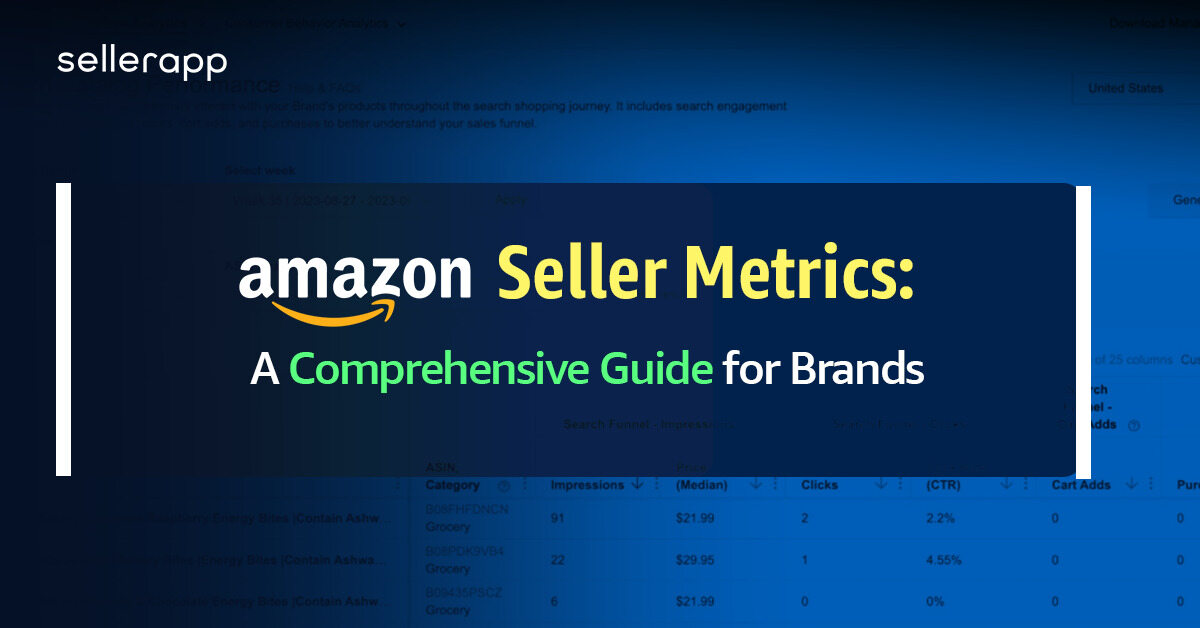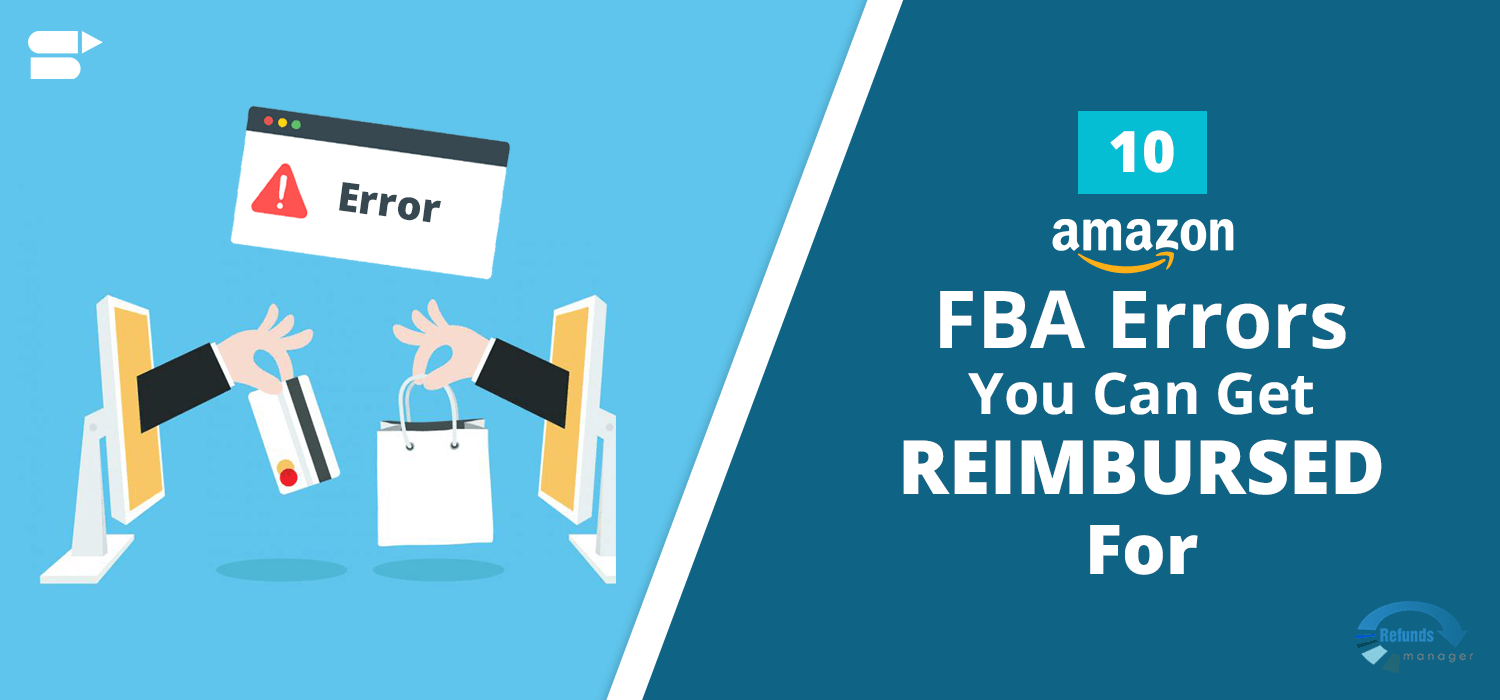6 Essential Amazon Seller Metrics for Measuring Marketplace Success

Amazon, where millions of products compete for attention, requires more than just listing your products and hoping for the best. On Amazon, success hinges on the ability to understand multiple Amazon Seller Metrics and leverage them to create strategies.
These metrics affect every aspect of a seller’s performance, from product visibility to customer trust.
To survive and thrive in this digital marketplace, sellers must understand and master these metrics.
This article explores the different Amazon Seller Metrics, and how it can help your business and products grow.
Here’s a sneak peek into the article:
- Why are Amazon Metrics Important?
- Top Amazon Metrics to Track
- Advertising Metrics
- Sales Metrics
- Inventory Metrics
- Account Health Metrics
- Return Rate Metrics
- Customer Metrics
- Conclusion
Why are Amazon Metrics Important?
Amazon metrics are crucial for sellers to track their performance, identify areas for improvement, and make data-driven decisions to optimize their business on Amazon. These metrics provide valuable insights into various aspects of an Amazon seller’s business, such as:
Advertising Effectiveness
Advertising metrics like Total Advertising Cost of Sales (TACoS), RoAS, and Advertising Cost of Sales (ACoS) help sellers measure the effectiveness of their advertising campaigns, optimize keyword targeting and bids, and maximize their return on advertising investment.
Sales and Profitability
Metrics like conversion rate, sales velocity, and total sales help sellers measure their overall sales performance, identify profitable products, and determine the effectiveness of their marketing campaigns.
Although the research process does have a learning curve, you can use tools like SellerApp’s free Amazon sales checker to get started.
Inventory Management
Metrics like inventory turnover, stockout rate, and late shipment rate provide insights into how effectively sellers manage their inventory levels, ensure adequate stock to meet customer demand, and minimize stockouts and returns.
Account Health
Amazon’s account health metrics, including the overall account health rating and individual performance metrics, reflect a seller’s compliance with Amazon’s policies and procedures, influencing their ability to sell on the platform and access valuable seller tools.
Return Rate
Metrics like return rate, return authorization request (RAR) rate and return reason analysis provide insights into product quality, customer satisfaction, and fulfillment practices, enabling sellers to identify and address issues that lead to returns.
Customer Satisfaction
Customer feedback metrics like product reviews, customer service response time, and order defect rate (ODR) help sellers gauge customer satisfaction, identify areas for improvement, and maintain a positive seller reputation.
By tracking and analyzing Amazon metrics, sellers can comprehensively understand their business performance, identify trends and patterns, and make informed decisions to improve their sales, profitability, customer satisfaction, and overall success in the Amazon marketplace.
Top Amazon Metrics to Track
As you have an idea about different Amazon metrics, now let’s get deeper into each of the metrics,
Advertising metrics
Here are the metrics you need to keep an eye on as an Amazon Seller.
Click-through Rate (CTR)
CTR is the percentage of people who see and click on your ad. It is calculated by dividing the number of clicks by the number of impressions.
Click-through Rate (CTR) measures the effectiveness of your ad and how many people click on it after seeing it. A higher CTR suggests that your ad is relevant to the audience and captures their attention.
Here’s the formula,
CTR = Number of Clicks / Number of Impressions
For example, if your ad has 10,000 impressions and 200 clicks, your CTR would be 2%. This means that 2% of the people who saw your ad were enticed enough to click on it.
Cost Per Click (CPC)
Cost Per Click (CPC) represents the average amount you pay for each click on your Amazon ad. It is calculated by dividing your total advertising costs by the number of clicks. CPC reflects the efficiency of your advertising spend on generating clicks. A lower CPC indicates that you are getting more clicks for your money.
Here’s the formula,
CPC = Total Advertising Costs / Number of Clicks
For instance, if you spend $50 on Amazon advertising and receive 100 clicks, your CPC would be $0.50. This means you are paying $0.50 for each person who clicks on your ad.
CPC is a good measure of the cost-effectiveness of your advertising campaigns.
Conversion Rate (CVR)
CVR represents the percentage of people who see your ad and then make a purchase. It is calculated by dividing the number of conversions by the number of clicks.
Conversion Rate (CVR) measures the effectiveness of your Amazon ad in driving sales. A higher CVR indicates that your ad is converting well and is successfully generating sales.
Here’s the formula,
CVR = Number of Orders / Number of Clicks
For instance, if your ad has 10,000 clicks and 100 purchases, your CVR would be 1%. This means that 1% of the people who saw your ad went on to make a purchase.
Advertising Cost of Sales (ACoS)
Advertising Cost of Sales (ACoS) is a crucial metric that measures the profitability of your Amazon advertising campaigns. It compares the amount of money you spend on advertising to the revenue generated from those ads. A lower ACoS indicates that your advertising campaigns are efficient and generate more revenue for the amount of dollars spent on advertising.
Here’s the formula:
ACoS = Total Ad Spend / Sales Generated from Advertising
For example, if you spend $100 on Amazon advertising and generate $500 in sales from those ads, your ACoS would be 20%. This means that for every dollar spent on advertising, you are generating $5 in sales.
To learn more about ACoS, check out this article.
Total Advertising Cost of Sales (TACoS)
ACoS is a more comprehensive measure of your advertising costs than ACoS. The Total Advertising Cost of Sales (TACoS) is a metric used to measure ad spending relative to total ad revenue (organic + PPC). TACoS helps you view your overall ad performance and business profitability well.
Here’s the formula:
TACoS = (Advertising Spend / Total Revenue) x 100
For example, if you spend $1000 monthly on Amazon advertising and generate $10,000 in total revenue from organic and PPC sales, then your TACoS would be 10%.
Return on Advertising Spend (ROAS)
Return on Advertising Spend (ROAS) is the most critical metric for evaluating the effectiveness of your advertising campaign. It compares the sales revenue generated from advertising to the corresponding advertising spend. ROAS is the inverse of ACoS. A higher ROAS indicates that you are generating more sales for every dollar you invest in advertising.
Here’s the formula,
ROAS = Sales Generated from Advertising / Total Ad Spend
For example, if you spend $100 on Amazon advertising and generate $500 in sales from those ads, your ROAS would be 5.
Sales Metrics
Here are the top sales metrics you need to give importance. They are:
Total Sales
Total sales is the gross revenue generated from all sales activities on Amazon. Total sales include all orders, regardless of discounts, returns, or refunds.
Net Sales
Net sales are the total sales amount after deducting returns, discounts, and allowances on Amazon. It represents the actual revenue generated after accounting for any adjustments or reductions in revenue. Net sales provide a more accurate picture of the profitability of sales.
Average Order Value (AOV)
Average order value (AOV) is the average amount of money customers spend on a website or store each time they buy something. It is calculated by dividing the total revenue by the total number of orders placed in a specified time. The formula is:
AOV = Total revenue / Number of Orders
AOV is considered one of the most important metrics in the e-commerce industry as it provides insights regarding customer behavior. A higher AOV suggests that a business is driving sales by promoting more expensive products or cross-selling
Repeat Purchase Rate (RPR)
Repeat purchase rate is the percentage of customers who make more than one purchase from a business. The RPR is expressed as a percentage. It is calculated by dividing the number of repeat customers by the number of total customers.
Formula,
RPR = (Number of repeat customers/ Total number of orders) x 100
The total number of customers is the sum of both one-time and repeat purchase customers. The repeat purchase rate is a measure of customer loyalty and satisfaction.
Buy Box Percentage
The Amazon Buy Box Percentage is a crucial metric that indicates the percentage of times a seller’s product appears in the prominent “Buy Box” on Amazon product pages.
This coveted position significantly influences purchasing decisions, allowing customers to add items directly to their carts with a single click.
Achieving a high Buy Box percentage is a significant goal for Amazon sellers, as it translates directly into more sales and increased revenue.
Inventory Metrics
Here are a few inventory metrics you need to give importance to:
Inventory Turnover Ratio
For Amazon, the Inventory Turnover Ratio is crucial as it helps you to maintain an optimal stock level and sell your stocks quickly. The ratio measures the number of times a seller’s inventory is sold and replaced within a specific period, typically one year. The ideal ITR for Amazon sellers is to aim in between 5 and 10.
Formula:
Inventory Turnover Ratio = Total Cost of Goods Sold / Average Inventory During a Period of Time
For instance, if a seller has a cost of goods sold (COGS) of $100,000 and an average inventory value of $20,000, their inventory turnover rate would be 5. This means that their inventory is sold and replaced five times within a year.
Inventory Performance Index (IPI)
Inventory Performance Index is a specific metric Amazon uses to measure how well sellers manage their inventory. The IPI ranges from 0 to 1000. A higher IPI score indicates good inventory management and meets Amazon’s expectations for inventory efficiency. It considers factors such as excess inventory, stranded inventory, sell-through rate, and in-stock rate. Here is an explanation of each factor.
- Excess Inventory: Amazon considers a product excess if it has over 90 days of supply based on the forecasted demand. If you have too much excess inventory and a low sales volume, then it can affect your FBA sell-through rate and indicate poor inventory management practices.
- Stranded Inventory: This refers to inventory that is not selling fast enough and is taking up a good portion of storage space.
- Sell-through Rate: This metric tells you how quickly your inventory is being sold. This metric is calculated by dividing the total number of units sold in the past 90 days by the average number of units held at FBA during that period.
- In-stock Rate: Amazon considers the percent of the time your replenishable FBA ASINs have been in stock during the last 30 days, weighted by the number of units sold for each SKU in the last 60 days. Replenishable products in stock help maximize your sales.
These factors are used to calculate the IPI score. This measures how efficient and productive you are at managing your FBA inventory.
Stockout Rate
Amazon’s stockout rate measures how often you run out of stock of a particular product. This reflects how well a seller forecasts demand and manages inventory levels to meet customers’ needs. A high stock-out rate indicates that your store has difficulty keeping up with customer demand, which can lead to lost sales and customer frustration. A low stock-out rate suggests that you have excess inventory.
FBA Storage Fees
FBA storage fees represent the charges that Amazon imposes on sellers for storing their products in Amazon’s fulfillment centers. These fees are based on the size and weight of the products and the amount of time they are stored in Amazon’s warehouses. Effective inventory management can help sellers minimize FBA storage fees by ensuring they have the right amount of inventory in stock at the right time.
Account Health Metrics
Amazon account health rating metrics are used to monitor your Amazon account health in Amazon Seller Central. You can use this metric to see the overview of your account performance and monitor it over time. Your account health will be based on the below attributes.
Order Defect Rate
The Order Defect Rate (ODR) is a critical metric that measures your ability to provide a good customer experience. It represents the percentage of orders with one or more indicators of poor customer service during a given 60-day time period. There are three components of Amazon’s Order Defect Rate, they are
- Negative Feedback Rate
- A-to-z Guarantee Claim Rate
- Credit Card Chargeback Rate
According to Amazon’s policy, sellers should maintain an ODR of less than 1% to sell on Amazon. An ODR above 1% may result in restriction of selling, including suspension of your seller-fulfilled orders.
Here’s how it’s calculated,
ODR = (Defected Orders / Total Orders Received) X 100
For example, if a seller has 100 orders and 5 of them result in defects, their ODR would be 5%. This means that 5% of their orders are causing dissatisfaction among customers.
Late Shipment Rate
Amazon’s Late Shipment Rate is a metric that shows the timeliness of your shipment. It measures the percentage of orders that are shipped after the expected date on Amazon. This rate applies only to seller-fulfilled orders.
Amazon requires sellers to maintain an LSR at or below 4%. If you exceed this threshold, then your Amazon account will be at risk of deactivation.
Here’s how it’s calculated,
LSR = (Number of orders shipped late / Total number of orders in a certain time)
This metric is calculated over both a 10-day and 30-day period. LSR is only applied to seller-fulfilled orders.
Cancellation Rate
The cancellation rate on Amazon is the percentage of orders that are canceled by the sellers. This is measured during a given 7-day time period.
This metric includes all the canceled orders by the sellers, including orders that Amazon automatically cancels because the seller did not confirm the shipment. If a customer cancels the pending order, then your order cancellation rate won’t be impacted.
According to Amazon’s policy, sellers should maintain a cancellation rate under 2.5% to sell on Amazon. If the cancellation rate is above 2.5%, it may result in the deactivation of seller-fulfilled orders.
On-Time Delivery Rate
The on-time delivery rate measures the percentage of orders that are delivered within the promised delivery date that appears on the seller central. This number is based on the packages that have confirmed tracking information.
Amazon recommends sellers maintain an OTD greater than 97% to provide a good customer experience. Failure to meet this metric could cause negative feedback or claims, impacting your selling account status.
Invoice Defect Rate
The Invoice Defect Rate (IDR) is a performance metric that tracks the percentage of orders for which sellers have failed to provide a valid invoice to Amazon Business customers. Sellers must maintain an IDR below 5% or risk account deactivation.
Amazon Business customers need invoices for tax and accounting purposes, so sellers need to provide them promptly and accurately. Failing to do so can lead to customer dissatisfaction and potential account suspension.
Return Rate Metrics
Return rates are an important metric for Amazon sellers to track, as they can significantly impact their business. Amazon sellers should strive to keep their return rates as low as possible.
There are three main return rate metrics that Amazon sellers should track:
Late Response Rate
The late response rate refers to the time it takes for you to respond to the customer’s request. Amazon sellers are required to respond to all customer inquiries and return requests within 48 hours.
Negative Return Feedback Rate
The negative return feedback rate is the valid return request that has received negative feedback from the customer. Amazon ensures that the seller resolves the customer’s return request properly. Negative return feedback can damage the seller’s reputation and make it difficult to attract new customers.
Customer Metrics
Customer metrics are essential for Amazon sellers to track and analyze, as they provide valuable insights into customer behavior, satisfaction, and loyalty. By understanding these metrics, sellers can identify areas for improvement and make data-driven decisions to enhance their business performance.
Here are six key customer metrics that Amazon sellers should focus on:
Customer Acquisition Cost (CAC)
Customer Acquisition Cost (CAC) is a metric that measures the average expense a brand spends to acquire a new customer. It’s calculated by dividing the total marketing and sales expenditures by the number of new customers acquired during a specific period. CAC helps to indicate the efficiency and profitability of your business.
The formula for Customer Acquisition Cost is
CAC = (Total marketing and sales expenses/ number of new customers)
For example, if a company spends $ 5,00,000 on marketing and sales monthly and gets 10,000 customers, its CAC is $50.
A low CAC indicates that the company can efficiently attract new customers, increasing revenue and profitability. A high CAC suggests that the company’s spending on customer acquisition is excessive, potentially reducing profit margin and overall financial health.
Customer Retention Rate (CRR)
Customer Retention Rate (CRR) measures the percentage of existing customers who continue to purchase from the seller over a given period. It is calculated by comparing the initial size of your customer base at the start of a certain period to the final number of customers after new customers have been added.
The formula for Customer Retention Rate is
CRR = (Total customers – New customers / Initial customers) x 100
This metric reflects your brand’s ability to establish strong customer relationships and highlights the value of repeat business.
Customer Lifetime Value (CLV)
Customer Lifetime Value (CLV) measures how much money you can expect to make from one customer over time. The business becomes profitable in the long run by retaining customers and increasing customer lifetime value. Understanding CLV is essential for a brand to identify challenges and opportunities.
To know more about Customer Lifetime Value, check out this article.
Product Review Rating
Product Review Rating is the average rating customers give to your products. Positive reviews can significantly boost product visibility and sales, while negative reviews can deter potential buyers. You should strive to maintain high product review ratings by ensuring product quality and customer satisfaction.
Negative Feedback Rate
Feedback is given by using a 5-star system. If you get two or one star, it is considered negative feedback. The negative feedback rate gives the percentage of orders that result in negative feedback from customers. If you see your negative feedback rate is high, you should find the cause and work towards resolution.
Negative feedback can damage the seller’s reputation and make it difficult to attract new customers. Addressing negative feedback promptly and professionally is crucial for maintaining customer trust.
In addition to tracking these metrics on Amazon Seller Central, you can also track metrics using third-party tools like SellerApp. SellerApp provides custom business reports to brands with advanced data visualization and integration to help sellers make impactful business decisions.
Conclusion
Understanding and effectively managing Amazon seller metrics is crucial for success in the competitive e-commerce landscape. These metrics influence your product rankings and play a significant role in building a positive reputation, enhancing customer satisfaction, and ultimately driving sales.
By consistently monitoring and optimizing these key performance indicators, sellers can meet Amazon’s standards and stand out in the marketplace, fostering long-term success and growth for their businesses.
Additional read:
Benefits of these Amazon add-on products
How to Join Amazon’s Small Business Academy
How does AmazonBasics impact Amazon Seller?
Amazon Advertising Audit Checklist











Jessica
December 18, 2023Detailed Information. thanks
Clare Thomas
March 7, 2024Glad you liked it.
Anjitha
December 18, 2023Knowledgeable data mentioned in the post!!
Clare Thomas
March 7, 2024Thank you for your feedback.